Tent city
A tent city is a temporary housing facility made using tents or other temporary structures.
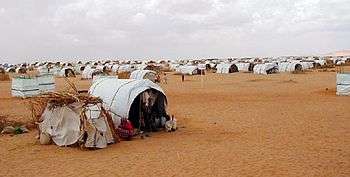
State governments or military organizations set up tent cities to house evacuees, refugees, or soldiers. UNICEF's Supply Division supplies expandable tents for millions of displaced people.[1]
Informal tent cities may be set up without authorization by homeless people or protesters.
Tent cities set up by homeless people may be similar to shanty towns, which are informal settlements in which the buildings are made from scrap building materials.
Military
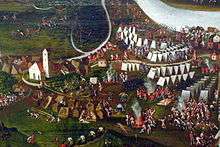
In the military, the term "tent city" usually refers to temporary living quarters erected on deployed military bases, such as those found in Bosnia and Herzegovina or Iraq. Depending on the branch of service and the length of time the tent city has been in place, the living space may be equipped with most modern amenities. For sanitary reasons, military tent cities place toilet, shower, and laundry facilities at least 50 feet (15 m) from living quarters. Also, tents are typically divided into clusters of 8-10 to prevent the rapid spread of fire, which is of utmost concern because of the tent and bedding materials.
Environmental disasters
Since Hurricane Katrina made landfall in August 2005, the term has been used to describe temporary housing sites set up for Gulf Coast residents who were left homeless by the storm. Some of the tents that were built by Seabees and funded by the U.S. Federal Emergency Management Agency (FEMA) are wooden structures covered by tents. With the exception of indoor plumbing, most of the tents have heat, air, and lights. The tent city can hold as many as 250 occupants. Displaced residents are only expected to stay for three to six months.
People Experiencing Homelessness
United States
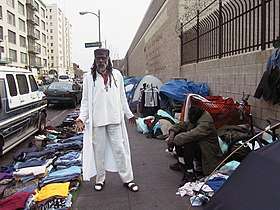
.jpg)
Camp Hope: Las Cruces, New Mexico
Camp Hope is an alternative transitional living project, for the homeless, in the form of camping. It is located on the Mesilla Valley Community of Hope (MVCH) campus and is an alliance of agencies that address homelessness in Las Cruces, New Mexico. The tent city can house 50 people that would otherwise be on the streets, providing them a safe place to seek direct services, healthcare, and find jobs and housing. Camp Hope has provided the homeless with the opportunity to be right next to all the Direct Services the agencies on the MVCH campus provide.[3]
The camp was founded in November 2011 with temporary permission from the city of Las Cruces. The camp was supposed to disband in March 2012, but there was no funding available to build another shelter and the City Council stated that the tent city benefited the city.
In 2013, with help from engineering students from New Mexico State University, the site was rezoned as a planned unit development (PUD) that sanctioned a permanent campground along with a number of other uses on the non-profit's campus.[4]
Homeless Charity Village: Akron, Ohio
This homeless tent village existed on private property owned by Sage Lewis in the Middlebury area of Akron Ohio from January 2017 until January 2019. It was originally known as Second Chance Village but changed its name due to conflicts with the original founders of the village.
The New York Times[5] wrote about this village, describing the homeless-run culture where the homeless created a drug-free, alcohol-free community with security officers and a democratically elected tri-council. All services were run by the homeless. These included laundry, showers, computer lab, clothing room and food pantry.
Akron City Council rejected Mr. Lewis's request for a zoning exception on an 8-to-4 vote in September 2018.
All tents were forced to be removed by January 5, 2019.[6]
California
.jpg)
The BBC did a news story,[7][8][9] which talked about how the causes of the crisis in the U.S. economy has forced many people, who used to own their own homes, to now live in tents.
AlterNet published a story[10] in 2009 about the mainstream media finally "discovering" the homeless situation in Sacramento.
St. Petersburg, Florida
In late December 2006, homeless people formed an impromptu tent city on the St. Vincent de Paul property in the 1400 block of Fourth Avenue N. of St. Petersburg in Saint Petersburg, Florida when dozens of homeless moved off of public land across the street from the society. In early January 2007, city officials noted city codes that prohibit living in tents and gave the society one week to evict the occupants of the tent city.[11]
Olympia, Washington
Camp Quixote, a homeless encampment began as a protest movement of homeless people and homeless advocates against criminalizing "anti-social" legislation that was passed by the city in January 2007 - specifically referring to the ordinance restricting people from sitting on sidewalks. City officials ordered the camp to disband. The Olympia Unitarian Universalist Congregation offered the encampment sanctuary on its property, being familiar with the Seattle faith-based network of homeless encampments. What began as a protest surrounding homelessness quickly became a faith community protest. The church community protested the city's insistence of dismantling the community on the grounds that churches maintain a specific land use right that allows them to offer sanctuary to the poor (Religious Land Use and Institutionalized Persons Act, or RLUIPA). Eventually, the adversarial protest turned to negotiation with local municipalities, with new ordinances condoning Camp Quixote with specific regulations and a ninety-day limit; option to move to other faith communities' property. Because of the ardent support of a volunteer team PANZA, the tent city is soon to be transformed into permanent supportive housing, Quixote Village - winter 2013.
Seattle, Washington

Homeless people have long resorted to seeking shelter in tents, but these communities are one of the first known to be organized by a sponsoring organization (a partnership between the Seattle Housing and Resource Effort and Women's Housing Equality and Enhancement League (SHARE/WHEEL)), and are one of the first in a major U.S. city to be largely accepted by local governments. Contrary to some stereotypes regarding the homeless, many residents of Tent City are employed, mostly in temporary or day labor jobs, but have insufficient income to obtain more permanent housing.[12]
The original Tent City and Tent City 2, both created in the late 1990s, were created illegally and opposed by the City of Seattle. After being tolerated for some time, they were eventually forced to shut down. In March 2002, as a result of a legal battle, city attorney Tom Carr and SHARE/WHEEL attorney Ted Hunter signed a court ordered consent decree with SHARE, allowing Tent City only on private land (by invitation) and setting standards for its operation.
Based on the consent decree Tent City 3 was created and rotates around the Metro Seattle Core. Tent City 4 was created in May 2004 as an attempt to expand beyond the consent decree and use public land and resources, something the consent decree does not allow. This attempt was unsuccessful and Tent City 4 has since been relocated to eastern King County where it is church sponsored. Tent City rules do not allow drug or alcohol use, and evicts anyone caught stealing or committing other crimes within the camp. Tent City 3 stayed an average of three weeks at each encampment before 2004, while Tent City 4 has stayed in place for as long as 100 days. Tent City 3's stays have since then averaged between 60 and 90 days, with 90 days or so being a common length of stay. Cities have been adopting code amendments that limit stays to 60–90 days.
Another homeless encampment, unaffiliated with Tent City 3 and 4, lived in donated, mainly fuchsia, tents at the University Congregational United Church of Christ in Seattle's University District[13] for several months ending March 5, 2009, at which time it moved to the suburb of Bryn Mawr south of Seattle.[14] According to[15] homeless advocates, residents criticized Seattle Mayor Greg Nickels for continuously clearing out homeless encampments, and named their encampment "Nickelsville". The church itself, out of respect for recent efforts by Mayor Nickels, did not use the "Nickelsville" name in referring to the encampment.[16]
While on the road in Seattle, Washington, on March 30, 2009, Democracy Now! covered a story[17] about Seattle's Nickelsville. They also covered a story about the police raid on Nickelsville the previous day, March 29, where 24 people were arrested.[18]
King County, Washington
Tent City 4 (TC4) is a homeless encampment of up to 100 people created in May 2004 in eastern King County outside of Seattle. Residents are adult men and women, although there is a provision for quartering minor dependents in emergency situations.
Transition Park, Camden, New Jersey
A community of 50 to 150 people had taken up residence in Camden, New Jersey, nestled on the right side of the ramp of I676 West exit 5A. Although attempts have been made to find housing for the population, no one in the community has been placed. Transition Park's Mayor and City Council continued to protect their community and seek medical attention for those in need. In May 2010, residents were forced out of the city and into local missions.
Under the leadership of Amir Khan, the pastor of Solid Rock Worship Center in Clementon, NJ, and founder of the Nehemiah Group, a faith-based nonprofit organization that Khan and his son Micah run, 54 residents of Tent City were moved to the Wingate by Wyndham Hotel in Mount Laurel in May 2010 with the help of volunteers. Pastor Khan asked his congregation and local business members for help and was able to raise $250,000 to provide some homeless people of Camden's Tent City with housing and human services for at least one year.
Although these homeless men and women were initially moved to a hotel and received a spa treatment upon arrival, months later drugs and alcohol are taking a toll on their adjustment to life in their new environments. On a positive side, Lorenzo Banks, the ex-self-appointed Mayor of Tent City and James Boggs, another Tent City leader got jobs providing homeless outreach for Volunteers of America-Delaware Valley in Collingswood, NJ. Although several people also enrolled in community college, mental illness, addiction issues and a lack of affordable housing illustrate the road blocks to a healthy life for Tent City residents over the long-term.
By September 13, 2010, 19 of the original 54 were removed from the "hotel program" and many former Tent City residents continue to move from one street corner or overpass to another, continuing the homelessness issue in Camden.[19][20][21][22][23][24][25][26]
Potomac mills, Woodbridge, Virginia
Since ca. 2003 there exists a 10 acres (4.0 ha) tent city at Potomac mills in Woodbridge, VA, adjacent to the Potomac Mills mall. It is tolerated by the private landlord. In 2018, part of the residents were directed to leave.[27]
Other cities
Tent cities are also found in the following cities: Ann Arbor, Michigan; Chattanooga, Tennessee; Columbus, Ohio; Athens, Georgia;[28] Reno, Nevada; Sierra Vista, Arizona; Providence, Rhode Island: Sacramento, California; San Diego, California; Lakewood, New Jersey; Lowell, Massachusetts; Huntsville, Alabama; Nashville, Tennessee; St. Louis, Missouri; Ft. Worth, Texas; and Buffalo, New York; Umoja Village, built by Take Back the Land, was a shantytown in Miami created to protest gentrification and a lack of low-income housing in Miami.
Canada
Toronto, Ontario
Toronto, Ontario, Canada's largest city, was also home to its own "Tent City" until September 2002, when the residents of Tent City were evicted by the owner of the property, Home Depot.[29] It was situated in the downtown core of Toronto, near the waterfront, and was home to hundreds of people who were homeless.
Tent City was mainly self-governed, as police would not usually enter it unless a major crime was committed. One of the oldest residents of Tent City became the appointed "Mayor Karl Schmidt" and oversaw the operation of the city and helped deal with the crime that did occur. In one instance a resident who was leaving Tent City sold his shelter twice to two separate individuals, making a profit for himself and leaving the buyers to resolve the dispute. There were also citizens who turned to theft in order to make money. Despite these conditions, there were some residents who felt more secure in Tent City than they did in the government shelters and chose to live in a self-regulated area where they could defend themselves.
When Tent City was closed, Home Depot evicted the residents with private security guards and the support of the Toronto Police Service. A formal property claim system was instituted where individuals were allowed to briefly return to the site to retrieve personal property before being permanently removed from the area. This action was criticized by activist groups as an attempt by Home Depot to clear land to develop a downtown big box outlet, however, the Ontario Municipal Board had previously ruled that a store could not be built on the site. After the eviction, the City of Toronto made shelter spaces available for each of the roughly 110 people removed. Three years later, at the end of 2005, the land remained undeveloped, and Home Depot has since opened a downtown outlet at Gerrard Square, a mall that sits on the corner of Pape and Gerrard.
Toronto introduced rent supplement programs in the following year (2002–2004) by which 115 residents were given access to mainstream apartment units.
Journalist Shaughnessy Bishop-Stall voluntarily abandoned his middle class lifestyle to live in Tent City for a year. He received very little outside assistance and begged for money to sustain himself. He detailed his experiences in a book, Down to This: Squalor and Splendour in a Big-city Shantytown.[30]
Events
Hajj
The Saudi Arabian government's Ministry of Hajj has set up a permanent tent city to house Muslim pilgrims in Mina, where the ritual Stoning of the Devil takes place as part of the overall Hajj pilgrimage to Mecca.[31] A tent city is also set up at Mount Arafat, another essential stop during the Hajj.[32] Because up to four million pilgrims may be performing the Hajj annually, the tent cities are densely inhabited with 20-40 people per tent. As such, fire and disease outbreaks were constant concerns. Since the late 1990s, Saudi authorities have started using fireproof tents to reduce the risks of a major fire.
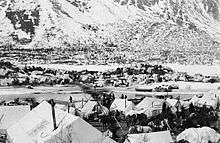
Klondike and Nome Gold Rushes
During the Klondike Gold Rush in Alaska and Canada 1896–1899 several tent camps were built along the routes to the gold fields especially on the popular Dyea/Skagway route where it met Lake Bennett and Lake Lindeman the head of Yukon River. At the Nome Gold Rush, between 1899 and 1909, a tent city sprung up that was 30 miles long, on the beaches and on the treeless coast of Nome, Alaska between Cape Rodney and Cape Nome.
Persepolis
For the festivities of the 2,500 year celebration of Iran's monarchy the Shah of Iran, Mohammad Reza Pahlavi, built a luxurious tent city in the desert next to the ruins of Persepolis to accommodate his international guests. The event took place October 12–16, 1971. The tent city was inspired by the tent city of the Field of the Cloth of Gold meeting between Francis I of France and Henry VIII of England that took place in 1520.
Other applications
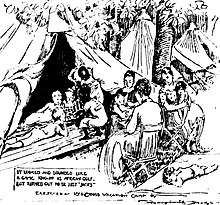
Fayette County, Tennessee
Tent City in Fayette County, Tennessee, was an encampment for displaced blacks who were removed from their homes and blacklisted from buying amenities as retaliation for registering to vote in the early days of the Civil Rights Movement.
West Virginia University
Throughout the week of October 26 to November 1, 2014, hundreds of West Virginia University students camped out in "Tent City" prior to ESPN's College GameDay.
Kent State University
On May 12, 1977, a tent city was erected and maintained for a period of more than 60 days by a group of several dozen protesters on the campus of Kent State University in Kent, Ohio, United States. The protesters, led by the May 4 Coalition but also including community members and local clergy, were attempting to prevent the university from erecting a gymnasium annex on part of the site where the Kent State shootings occurred in May 1970, which they believed would alter and obscure that historical event. Law enforcement finally brought the tent city to an end on July 12, 1977, after the forced removal and arrest of 193 people. The event gained national press coverage and the issue was taken to the U.S. Supreme Court.[33][34][35]
Music
Chicago band Patience Gloria's second album Consequences David has a song titled "Tent City Nation" that addresses the subject.
- Bolton Hall, activist who established a tent city in New York city in 1908
The area at music festivals for attendees to set up their tents for overnight stays is often called "Tent City".
Protests
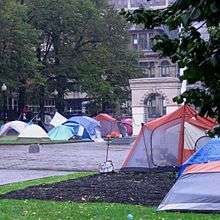
- Occupy movement is an international protest movement that featured tent cities set up in parks in some cities.
Maricopa County Jail modification
Prior to the election of Sheriff Joe Arpaio in 1993, the prisoner population in Maricopa County Jail, Arizona, the fourth largest jail system in the world,[36] exceeded the maximum number of inmates allowed in its facilities. Prisoners were routinely released from custody prior to completing their sentence due to the overcrowding. In a study conducted in 1993 it was estimated that construction of a new facility would cost approximately $70,000,000. Sheriff Arpaio, concerned about the cost of a new facility and reasoning that military tents were good enough for the men and women of the U.S. armed forces who fought in the Gulf War, ordered that tent jails be constructed using inmate labor.[37] It consisted of Korean War-era tents donated by the United States armed forces, and a 50 ft (15.4 m) observation tower with a vacancy sign mounted on the front. The final cost of the project was approximately $100,000 and it was capable of housing over 2,400 inmates. Tent City was closed in October 2017.[38]
References
- "Multipurpose Tents" (PDF). UNICEF Supply Division.
- John Edwin Fuder, Training Students for Urban Ministry: An Experiential Approach. Eugene, OR: Wipf & Stock (2001).
- "Hope Village Las Cruces". Hope Village Las Cruces. Retrieved 23 July 2015.
- Andrew Heben. "Tent City Urbanism: Camp Hope — Las Cruces, NM". Archived from the original on 2015-07-23. Retrieved 23 July 2015.
- Smith, Mitch (2018-10-16). "Why a Private Landowner Is Fighting to Keep the Homeless on His Property". The New York Times. ISSN 0362-4331. Retrieved 2019-07-04.
- Conn, Jennifer; reporter, Akron; clevel; .com (2019-01-04). "Akron's tent city is gone but activist's work with the homeless will continue". cleveland.com. Retrieved 2019-07-07.
- Wendy Urquhart (2008-03-14). "Tent cities spring up in LA". BBC. Retrieved 2008-04-23.
- "Tent city highlights US homes crisis". BBC. 2008-03-14. Retrieved 2009-01-09.
- Various authors (2008-03-19). "Welcome To Tent City - America Style". Crooks and Liars. Archived from the original on 2008-03-24. Retrieved 2008-04-23.
- Rose Aguilar (2009-04-20). ""People Shouldn't Have to Live Like This": The Real Story Behind "Tent City" -- and How the Media Get It Wrong". Alternet. Retrieved 2009-04-20.
- Robert Farley (2007-01-08). "Pickets greet mayor at church". St. Petersburg Times. Retrieved 2007-01-10.
- The SHARE/WHEEL Tent City Project Archived 2008-03-12 at the Wayback Machine
- "'Nickelsville' may get new church site". seattlepi.com. Retrieved 23 July 2015.
- Dailyuw.com Archived 2012-07-08 at Archive.today
- "Nickelsville homeless encampment will switch to new University District site". The Seattle Times. Retrieved 23 July 2015.
- "Get to know the real people in tents". seattlepi.com. Retrieved 23 July 2015.
- "A 21st Century Hooverville: Seattle's Homeless Population Builds "Nickelsville," a Tent City Named After the City's Mayor". Democracy Now!. 2009-03-30. Retrieved 2009-04-20.
- "Seattle Police Arrest 24 People at Nickelsville Tent City". Democracy Now!. 2009-03-29. Retrieved 2009-04-20.
- "Welcome To "Transition Park", The Horrible Tent City In Camden, NJ". Business Insider. 6 May 2010. Retrieved 23 July 2015.
- Official Website of Transition Park Tent City Archived 2010-09-10 at the Wayback Machine
- "Tough times for former residents of Camden's Tent City". philly-archives. Retrieved 23 July 2015.
- "Courier-Post: Archives". Retrieved 23 July 2015.
- "N.J.'s Tent City closes as homeless go to hotel - US news - Giving - NBC News". NBC News. Retrieved 23 July 2015.
- "Courier-Post: Archives". Retrieved 23 July 2015.
- As Camden's Tent City closes, residents get spa treatment
- Some former Tent City denizens back in another encampment
- "wusa9.com". wusa9.com. Retrieved 2018-03-01.
- "Cops trim borders of Tent City". Athens Banner-Herald. 2008-03-13. Archived from the original on 2009-10-03. Retrieved 2010-08-08.
- "Homeless evicted from Toronto's 'tent city'", cbc.ca, September 25, 2002.
- Down to This: Squalor and Splendour in a Big-city Shantytown, City of Toronto Book Awards.
- "Mina". Ministry of Hajj, Kingdom of Saudi Arabia.
- "Arafat". Ministry of Hajj, Kingdom of Saudi Arabia.
- "Tent City Archives". Four Dead in Ohio : May 4, 1970.
- "Gym Annex Controversy (Tent City) records". Kent State University Libraries : Special Records and Archives. Kent State University.
- Patterson, Doug (August 1977). "Tent City at Kent State" (PDF). Socialist Worker. p. 11.
- NICE Systems - Press Releases - Maricopa County Sheriff's Office Installs NiceVision in Madison Street Jail Archived 2007-10-23 at the Wayback Machine
- MCSO: Tent City Jail Archived 2015-01-17 at the Wayback Machine dead link
- Maricopa County's Tent City jail officially shut down
External links
| Wikimedia Commons has media related to Tent cities. |
- Tent City Urbanism: From Self-Organized Camps to Tiny House Villages by Andrew Heben
- Seattle University hosting Tent City 3
- Temporary Autonomous Shelter (Tent Cities) Research Portal
- Waaytv.com
- Cities Tolerate Homeless Camps by Jennifer Levitz, The Wall Street Journal, August 11, 2009
- Tent City Forum for homeless people.
- Tent City Chicago homeless interview
- Image of workers setting up tents for the homeless in a Tent City across the street from City Hall in Los Angeles, California, 1984. Los Angeles Times Photographic Archive (Collection 1429). UCLA Library Special Collections, Charles E. Young Research Library, University of California, Los Angeles.